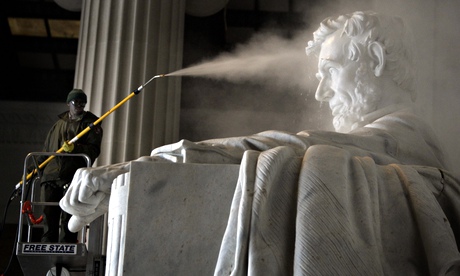
Washington DC is an awkward city. Like New York City, its significance transcends the geographical boundaries of the metropolis, but unlike New York, the city's urban design is such that it's almost hard to see it as a city at all. The boroughs of New York are demarcated and distinct, as are the north and south sides of Chicago; in Washington, the districts of Virginia, Maryland, and Columbia tend to blur city centre into suburb inextricably. The different tenor of the urban environment perhaps accounts for the way its literature is probably the least "urban" of all the cities on this list.
Washington is predominantly, of course, America's political centre, and, "Bartleby" and Little Dorrit aside, bureaucracy doesn't tend to make for great literature. There are, however, some exceptions here: Democracy, by Henry Adams, is an incisive study of politicians, socialites, wannabes, and the nature of power that has aged remarkably little since its first publication, anonymously, in 1880. The political system is seen through the eyes of Madeleine Lee, an outsider who moves to the city seeking "the mysterious gem which must lie hidden somewhere in politics", and her salon soon becomes the place to see and be seen in Washington. But she rapidly becomes the object of an increasingly vicious conquest by two ambitious, machiavellian politicians, and by the end she leaves, disillusioned, for Egypt. Adams believed absolutely that the future of the world lay in the United States and that the future of the United States lay in Washington, but as Madeleine declares, "half of our wise men declare that the world is going straight to perdition; the other half that it is fast becoming perfect. Both cannot be right. [...] I must know whether America is right or wrong." It isn't clear if Adams himself could quite make his mind up.
To a certain extent Washington, just like those politicians, is probably a little lost and beguiled by its own mythology: the White House, the Capitol, the Lincoln memorial, the Washington monument, the Jefferson memorial … It's hard for a literature of the city to carve out an identity more striking than that already inscribed in its architecture. This tension is perfectly captured by Gore Vidal in his memoir of political life, Palimpsest. To give just one example:
"In June of the year 1957, my half sister, Nina (known henceforward as Nini) Gore Auchincloss, married Newton Steers in St John's Church, 'the church of the presidents,' in Washington, DC. For over a century presidents, of a Sunday, would wander across the avenue that separates White House from Lafayette Square and its odd little church, whose chaste Puritan tower is topped by an unlikely gold Byzantine dome – metaphor?"
The superimposition of history and ideology over the urban fabric as the scene slips back temporally through the decades, physically haunting the lives of its citizens, is brilliant. Is it a metaphor? And if so, what is the metaphor (the wandering presidents, the paradoxically gilded puritan tower, or the juxtaposition of federal and quotidian concerns) and what, if anything, might it signify? The question-mark is provoking.
There is of course the one landmark not celebrated in Washington folklore: Ford's theatre, scene of Abraham Lincoln's assassination in 1865, to which a visit can only be complete accompanied by a copy of When Lilacs Last in the Dooryard Bloom'd, Walt Whitman's masterpiece commemorating Lincoln's death. Although starting with Whitman's typically familiar and intimate first-person voice – "Here! coffin that slowly passes,/ I give you my sprig of lilac" – the poem soon expands to articulate the collective grief of the nation:
"And the streets how their throbbings throbb'd, and the cities pent – lo, then and there,/
Falling upon them all and among them all, enveloping me with the rest,/
Appear'd the cloud, appear'd the long black trail,/
And I knew death."
A book for those not wishing to spend their holidays revelling in grief or contempt for the professional politician would be Lost in the City by Edward P Jones, a series of 14 stories moving street by street through the capital. Those who know Jones only for his Pulitzer prize-winning The Known World should definitely look at this collection. In each of the stories we are offered a brief, bare glimpse into the lives of ordinary working-class African Americans going about their daily business, each seeking a way of sustaining faith amid the alienation and disillusion of modern life, whether it's religion for the hymn group in 'Gospel', the bonds of community for the narrator of 'The Store' who tries to build a neighbourhood grocery, or the innocence of the birds Betsy cares for on the roof of her apartment in 'The Girl Who Raised Pigeons'. This is the poverty of African American neighbourhoods uplifted by a spirit of hope which is a refreshing prism through which to wander around this most disillusioned, and disillusioning, of cities.

